Overview
This article outlines six essential steps for mastering company branding, which are crucial for achieving marketing success. It focuses on:
- Defining brand identity
- Identifying target audiences
- Crafting a unique value proposition
- Developing visual identity
- Implementing branding strategies across channels
- Regularly analyzing and refining branding efforts
Each step underscores the importance of understanding customer needs, maintaining consistency, and adapting to market changes. By doing so, organizations can enhance brand recognition and foster customer loyalty. These strategies not only solidify a brand's presence in the market but also create lasting connections with consumers.
Introduction
Crafting a compelling brand identity is not merely a marketing strategy; it is an essential requirement for businesses aiming to excel in today's competitive environment. By mastering the art of branding, companies can forge meaningful connections with their audience, bolster customer loyalty, and articulate their unique value propositions with clarity. Yet, in the face of ever-evolving market dynamics and shifting consumer expectations, how can businesses ensure that their branding efforts remain both relevant and impactful? This guide explores six crucial steps designed to empower organizations to refine their branding strategies and achieve marketing success.
Define Your Brand Identity and Purpose
To effectively define your brand identity and purpose, begin by addressing these essential questions:
- What are your fundamental principles? Identify the fundamental principles that guide your business decisions and interactions. These principles are essential for creating a solid basis for your identity.
- What is your mission statement? Create a concise statement that summarizes your company's purpose and objectives. A clear mission statement not only communicates your goals but also resonates with consumers who share similar values.
- What is the narrative of your label? Articulate the narrative behind your company's inception, including the challenges faced and milestones achieved. A compelling narrative fosters emotional connections, enhancing consumer loyalty and engagement.
- What emotions do you want to evoke? Reflect on the emotions you wish to evoke in your audience during their engagements with your company. Emotional resonance is a key driver of loyalty to labels, particularly as consumers increasingly prioritize labels that align with their values.
Once these elements are clearly defined, compile them into a comprehensive identity guideline document. This document should encapsulate your identity and purpose, ensuring that all team members are aligned with your vision. By establishing robust brand guidelines, you create a cohesive framework that enhances internal collaboration and strengthens your brand's market presence.
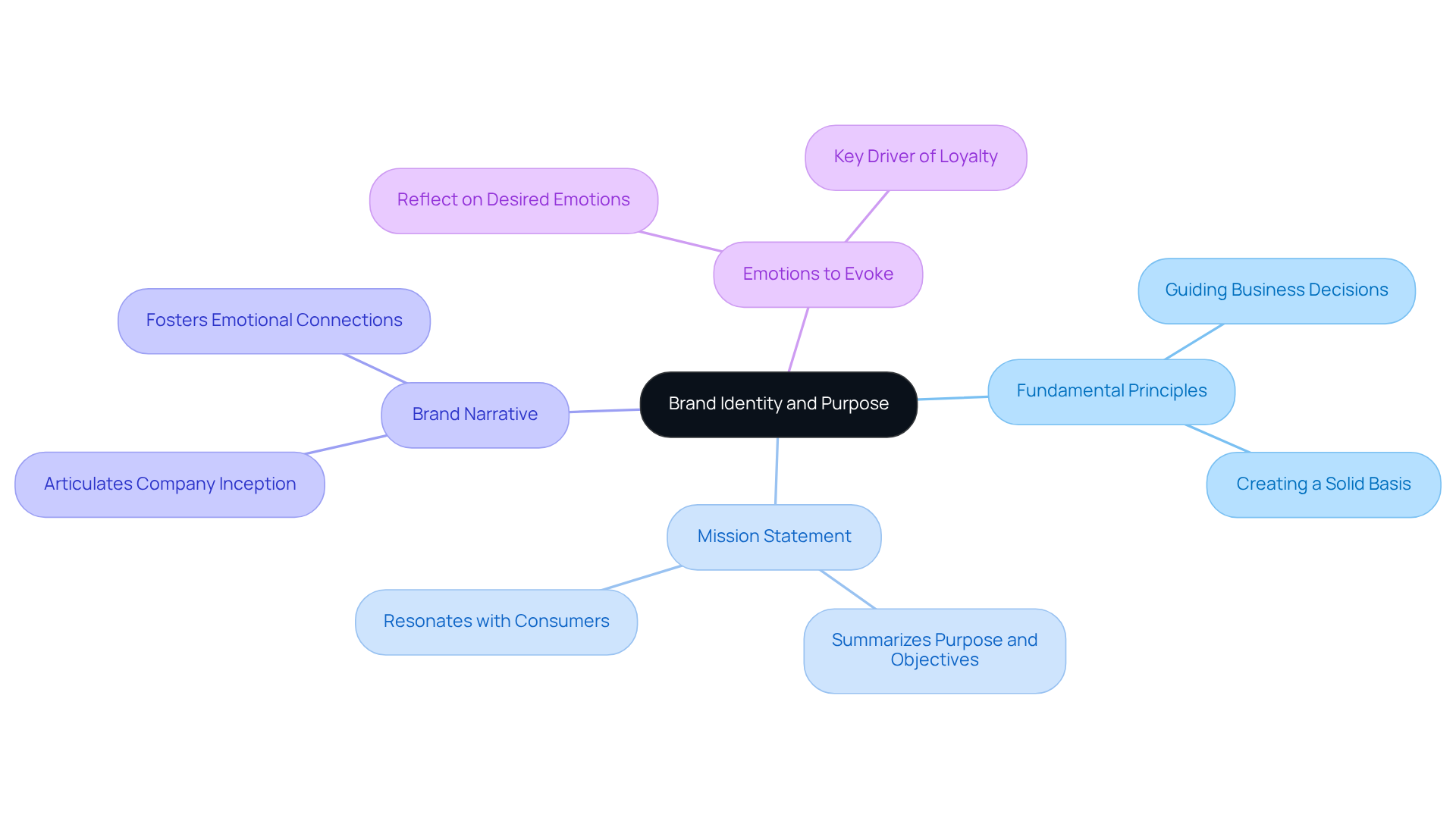
Identify Your Target Audience and Market Position
Identifying your target demographic and market position is essential for effective branding. Follow these steps to refine your approach:
-
Conduct Market Research: Utilize surveys, focus groups, and social media analytics to gather comprehensive data about potential customers. This research should focus on understanding demographics, psychographics, and consumer behavior, which are essential for developing effective marketing strategies.
-
Create Customer Personas: Develop detailed profiles of your ideal customers, incorporating demographics, interests, and pain points. Research indicates that nearly 67% of marketers create customer personas to guide their marketing efforts, enhancing engagement and conversion rates. Tailoring your messaging to these personas fosters stronger connections with your listeners.
-
Analyze Competitors: Study your competitors to gain insights into their target audience and market positioning. Identifying gaps in the market can reveal opportunities for your business to distinguish itself and meet unfulfilled consumer needs.
-
Define Your Unique Selling Proposition (USP): Clearly articulate what sets your brand apart from competitors. Comprehending your USP enables you to convey how your offerings more effectively satisfy the requirements of your intended group, ultimately fostering engagement and loyalty.
By thoroughly understanding your target group and market position, you can tailor your branding strategy to effectively reach and engage your ideal customers, ensuring a more impactful presence in the marketplace.
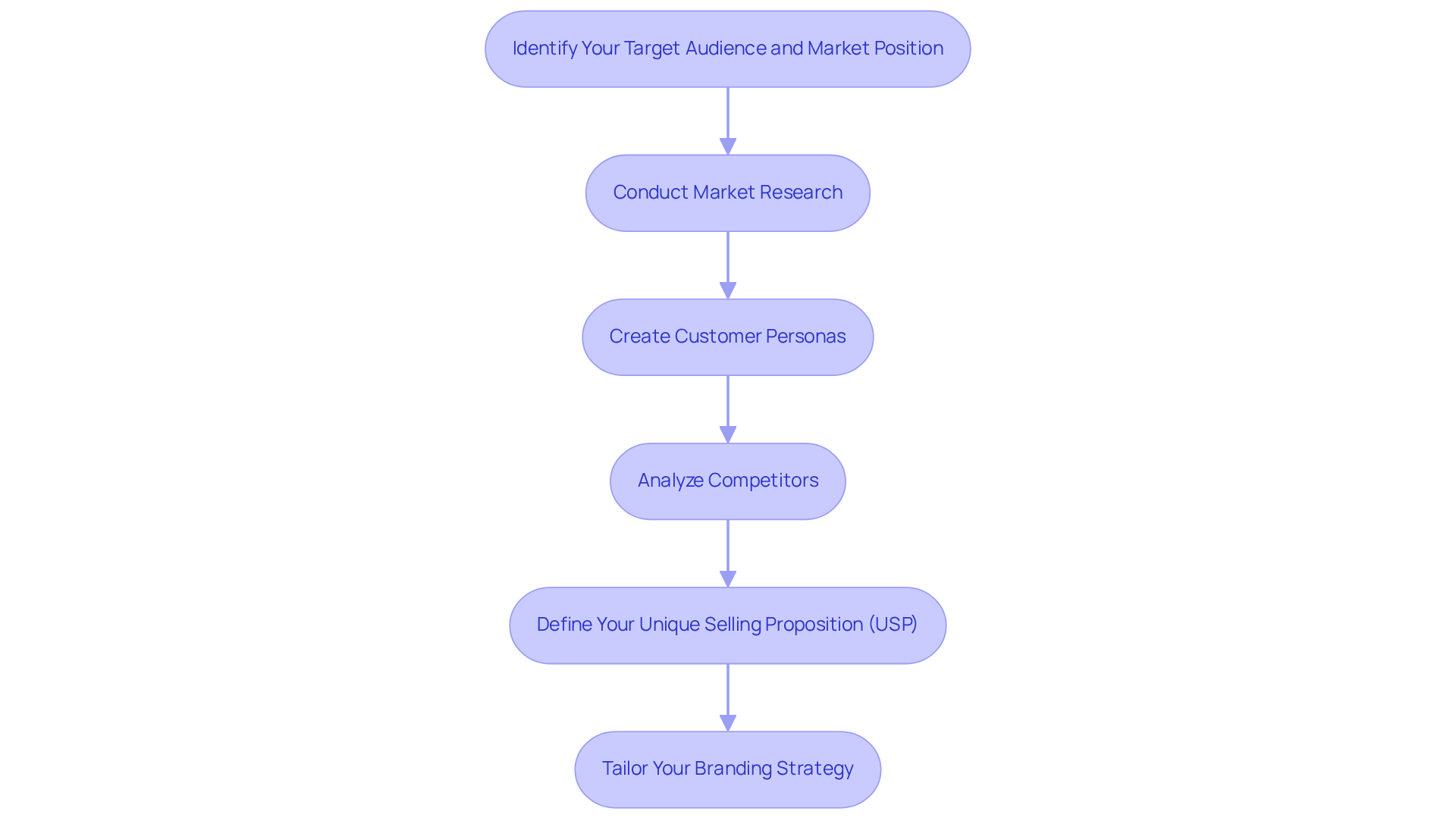
Craft Your Unique Value Proposition
To craft an effective unique value proposition (UVP), follow these essential steps:
-
Identify Customer Needs: Begin by analyzing the specific challenges your target audience encounters. Understanding these pain points is crucial for developing solutions that resonate with them. At Overskies, we emphasize that your customers are people, not mere data points. We prioritize their intent and context in our approach.
-
Highlight Key Benefits: Clearly outline the primary benefits your product or service offers. Focus on what differentiates your offering from competitors, ensuring that these unique aspects are front and center. Our ethical approach honors your brand principles while showcasing the benefits your solutions provide.
-
Research Competitors: Examine competitors' offerings to understand their strengths and weaknesses. This analysis will help you position your UVP effectively in the market, allowing you to craft a narrative that stands out.
-
Create a Clear Statement: Synthesize your findings into a concise statement that encapsulates your UVP. For example, you could state, "Our product provides [specific benefit], allowing [target group] to attain [desired outcome]." This clarity helps potential customers quickly grasp the value you provide.
-
Test and Refine: Share your UVP with a segment of your target group to gather insights and feedback. This iterative process allows you to refine your proposition, ensuring it aligns with customer expectations and effectively communicates your brand's strengths. At Overskies, we leverage our research-driven process to ensure your UVP resonates with your audience.
-
Utilize Templates: Consider using available templates to brainstorm and refine your offering, making the process more structured and efficient.
A well-crafted UVP not only guides your company branding and marketing strategies but also enhances customer engagement and drives conversion rates. A compelling offering assists customers in making informed choices and provides them assurance in their purchase. Successful companies like Hoka exemplify this approach, with their statement, "Hoka makes you feel like you’re flying," succinctly conveying both the product's benefits and its unique positioning in the market. This aligns with Overskies' dedication to creating distinctive stories that connect with consumers, demonstrating how a robust offering can set apart a business in a competitive environment.
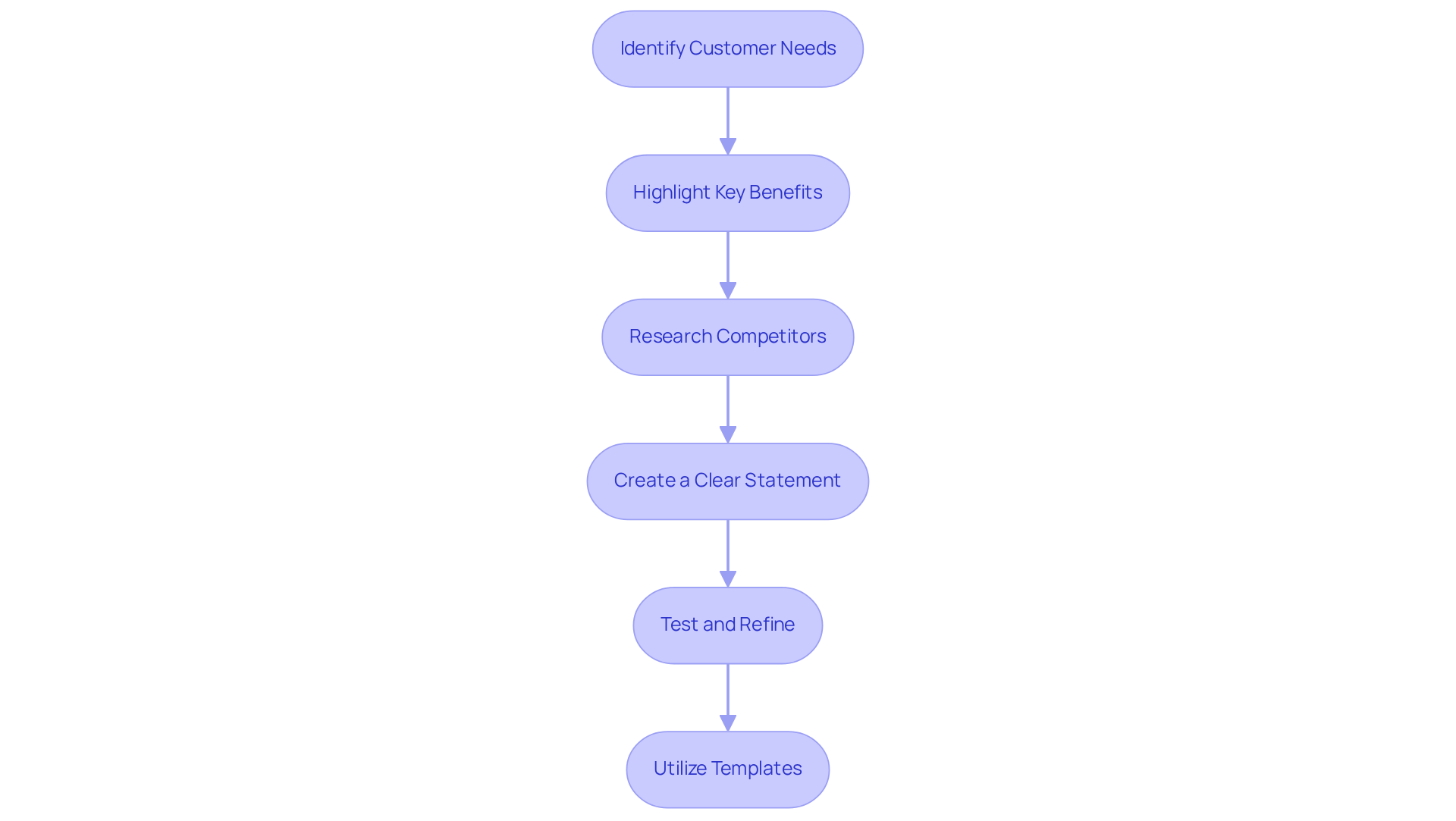
Develop Your Visual Identity and Brand Messaging
To effectively develop your visual identity and brand messaging, consider the following steps:
- Design a Logo: Your logo should encapsulate your identity and core values. Ensure it is versatile and scalable, maintaining clarity across various applications, from small icons to large formats.
- Choose a Color Palette: Select colors that evoke the desired emotions and align with your identity's personality. Studies indicate that color can enhance product recognition by as much as 80%, making consistency in color application crucial for creating a recognizable identity.
- Select Typography: Choose fonts that enhance your identity's tone and ensure readability across different platforms. The appropriate typography can express your identity, whether modern or traditional, enhancing overall perception.
- Craft Company Messaging: Develop key messages that clearly convey your organization's value and resonate with your audience. This involves creating powerful taglines, mission statements, and key messaging points that represent your identity.
- Create Identity Guidelines: Document your visual and messaging elements in comprehensive identity guidelines. This guarantees uniformity across all channels and touchpoints, reinforcing your identity and enhancing recognition.
A robust visual identity, along with unified messaging, not only enhances your company branding but also nurtures a lasting relationship with your viewers, ultimately boosting interaction and loyalty.
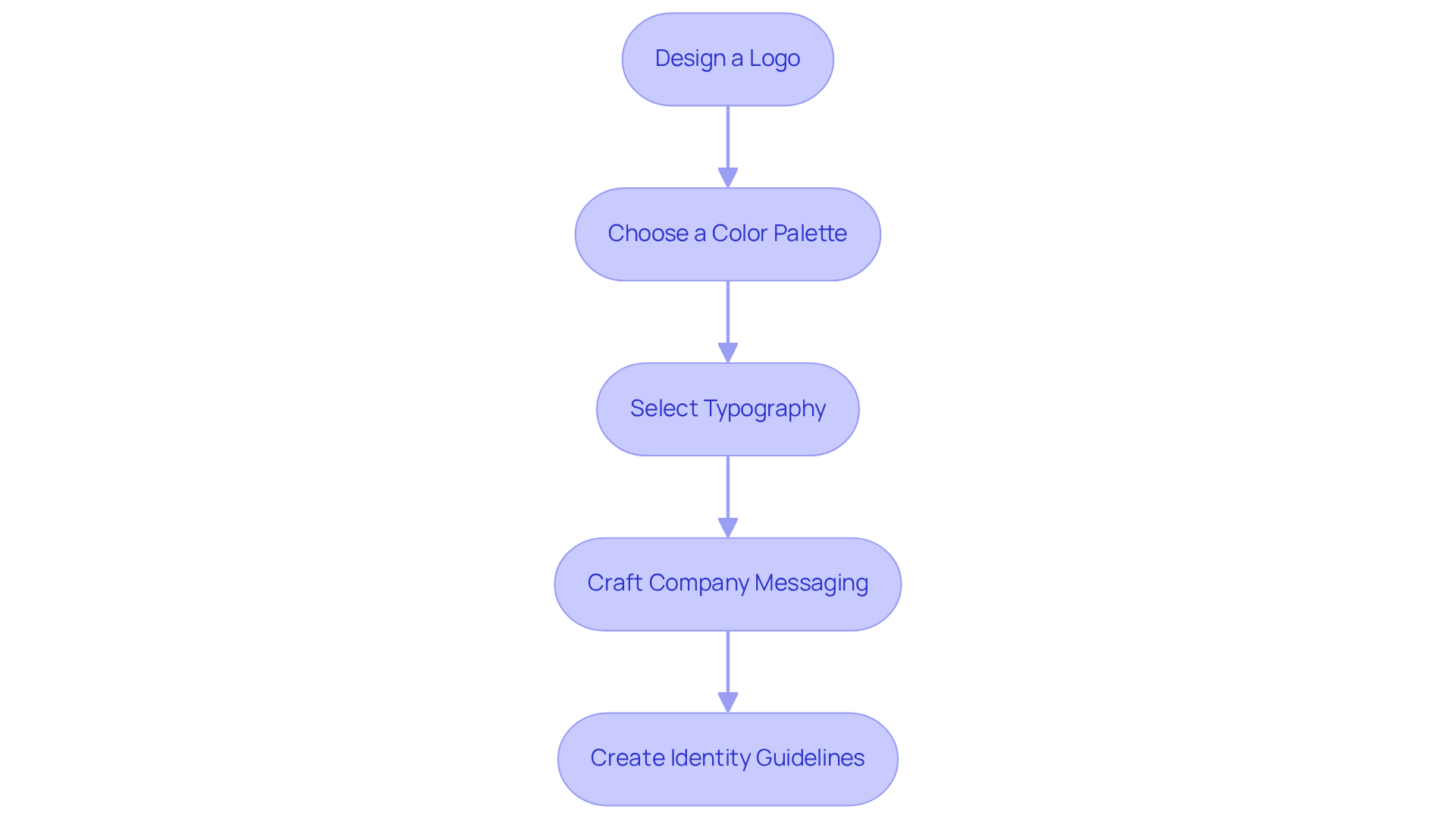
Implement Your Branding Strategy Across Channels
To effectively implement your branding strategy across various channels, follow these essential steps:
-
Choose Your Channels: Identify the platforms where your target audience is most active, such as social media, email, or your website. In 2023, Facebook claimed more than 2.8 billion monthly active users, while Instagram had 1.2 billion, emphasizing the significant opportunity for interaction on these platforms.
-
Tailor Content for Each Channel: Adapt your messaging and visuals to fit the unique characteristics of each platform while ensuring consistency across your identity. For instance, LinkedIn posts with images see a 98 percent higher comment rate compared to text-only content, demonstrating the need for platform-specific strategies.
-
Engage with Your Audience: Utilize interactive content, respond promptly to comments, and encourage user-generated content to foster community engagement. Brands that actively connect with their followers can build trust and loyalty, as positive interactions on social media enhance brand reputation.
-
Monitor Performance: Track the effectiveness of your branding efforts using analytics tools to understand what resonates with your target group. Metrics such as engagement rates and viewer feedback are crucial for refining your approach.
-
Adjust as Needed: Be flexible and willing to refine your strategy based on feedback from your viewers and performance metrics. Successful companies continuously adapt their content strategies, which is essential for effective company branding, to meet evolving consumer preferences and market trends.
By executing these steps, you can establish a unified experience that connects with your viewers, ultimately enhancing engagement and loyalty across all channels.
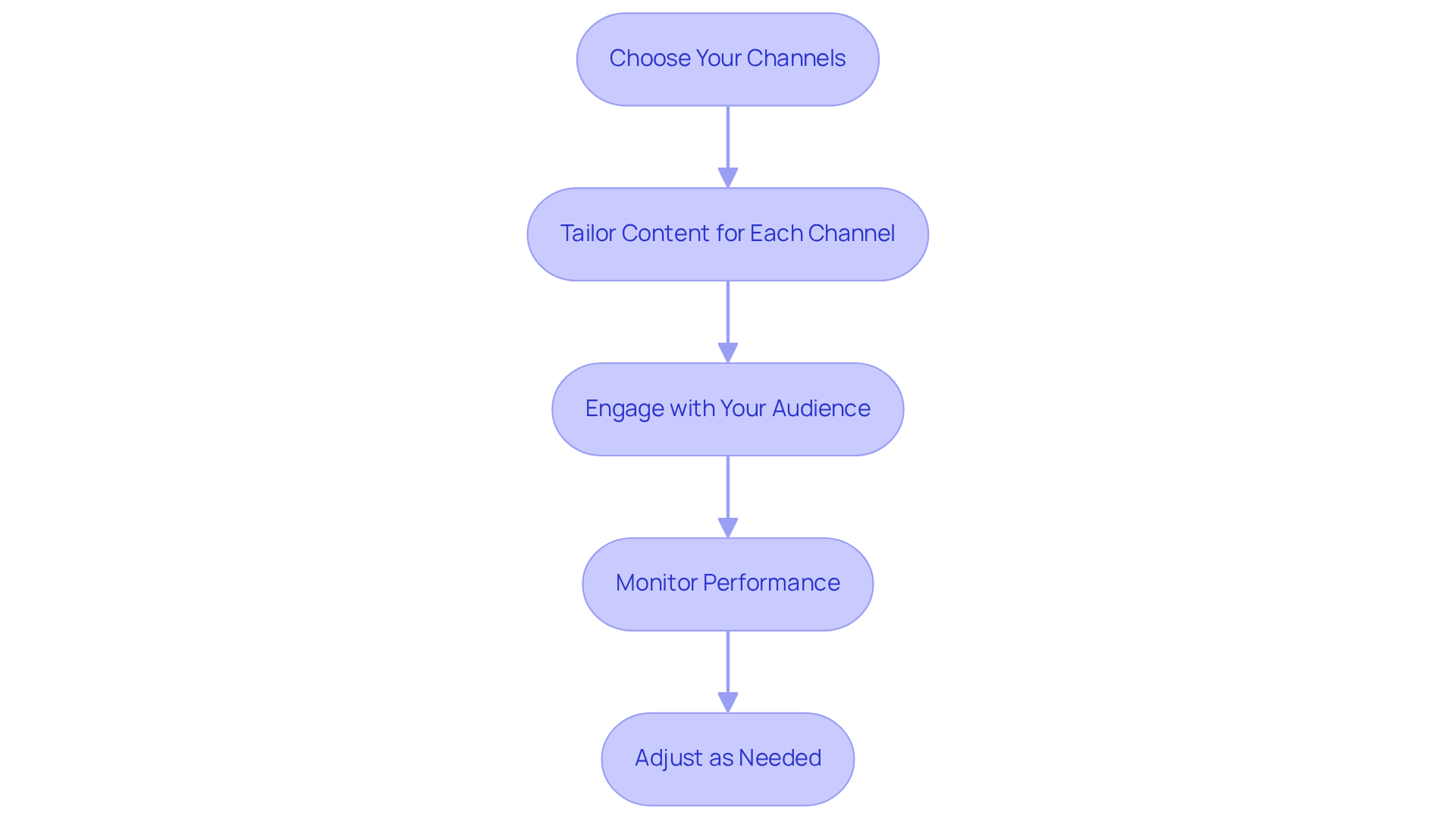
Analyze and Refine Your Branding Strategy Regularly
To effectively analyze and refine your branding strategy, consider the following steps:
-
Conduct Branding Audits: Regularly assess your organization's performance by evaluating customer feedback, market trends, and competitor strategies. Performing these audits at least once a year is essential to stay aligned with evolving consumer expectations and industry dynamics.
-
Gather Customer Insights: Utilize surveys, interviews, and social media listening tools to gain a comprehensive understanding of how your audience perceives your identity. Insights from non-customers can also uncover obstacles to participation, providing valuable information for strategic adjustments.
-
Evaluate Key Performance Indicators (KPIs): Monitor metrics such as product recognition, interaction rates, and conversion rates. Companies that examine their conversion rates can ensure that calls-to-action are clear and effective, ultimately improving user interaction.
-
Identify Areas for Improvement: Based on your analysis, pinpoint specific aspects of your branding strategy that require adjustment. This could involve refining your messaging, enhancing visual identity, or improving customer experience based on feedback.
-
Implement Changes: Make the necessary adjustments to your branding strategy and communicate these changes to your team to ensure alignment. Setting clear timelines and goals for these initiatives will help track progress effectively.
By consistently analyzing and refining your branding strategy, you can maintain relevance and ensure that your brand resonates with your audience, ultimately driving engagement and loyalty.
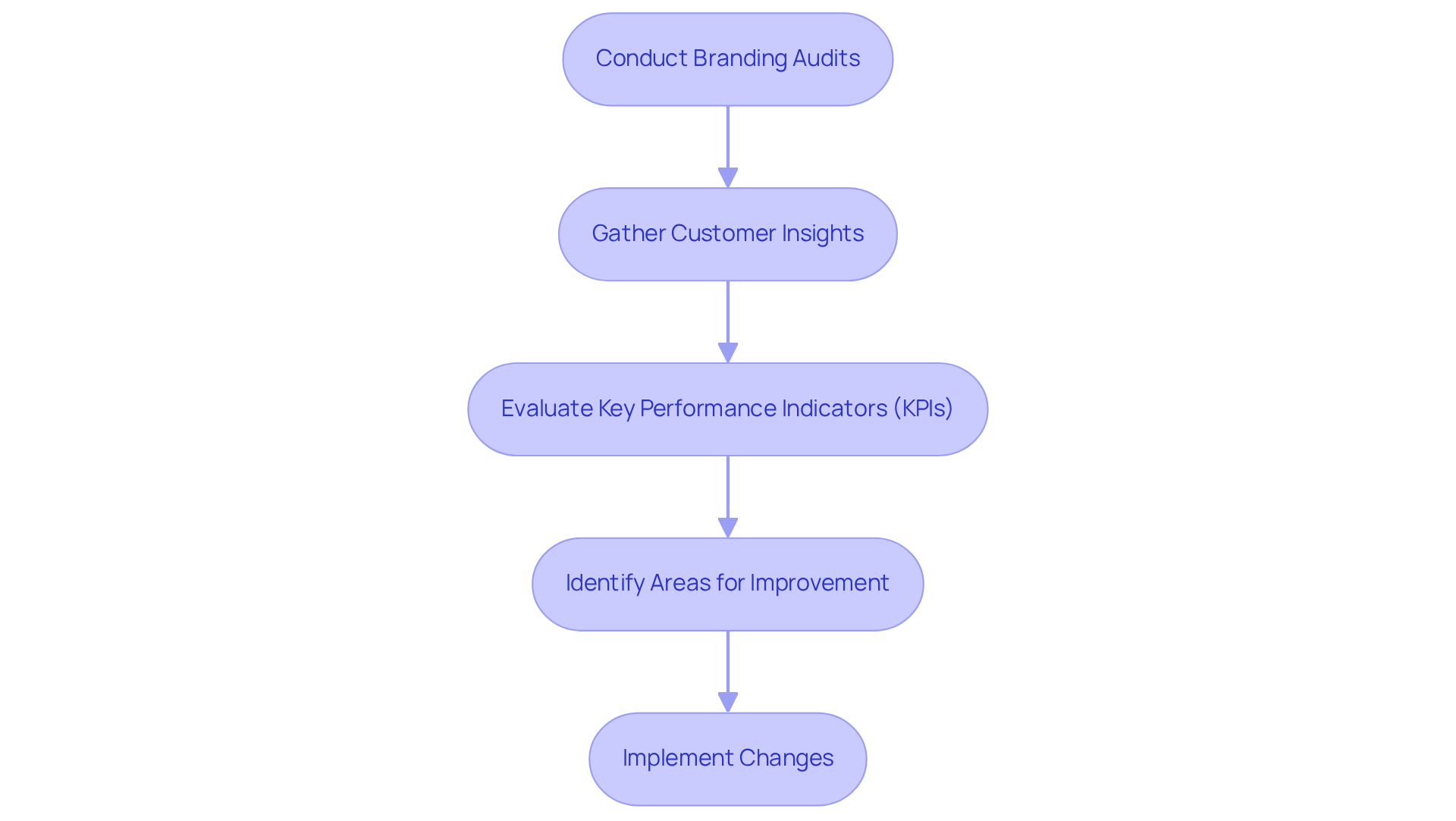
Conclusion
Mastering company branding is essential for achieving marketing success, as it establishes the foundation for how a business engages with its audience. By:
- Defining a clear brand identity
- Understanding target demographics
- Crafting a unique value proposition
- Developing visual identity
- Implementing strategies across various channels
- Regularly analyzing performance
companies can create a cohesive and memorable brand presence. Each step underscores the importance of aligning branding efforts with consumer expectations and market dynamics.
The article outlines a structured approach, emphasizing the necessity of:
- Defining brand identity and purpose
- Identifying target audiences
- Developing a compelling visual and messaging framework
It highlights the significance of tailoring branding strategies to resonate with consumers and adapting to market trends. Furthermore, the ongoing evaluation and refinement of branding strategies are crucial to ensuring that a company remains relevant and connected to its audience.
Ultimately, effective branding is not a one-time effort but an evolving process that demands dedication and adaptability. Companies should embrace these steps and continuously engage with their audience to foster loyalty and enhance their market position. By prioritizing branding as a core component of their marketing strategy, businesses can not only differentiate themselves from competitors but also forge lasting connections that drive success in an ever-changing landscape.
Frequently Asked Questions
How can I define my brand identity and purpose?
To define your brand identity and purpose, address key questions such as your fundamental principles, mission statement, company narrative, and the emotions you want to evoke in your audience. Compile these elements into a comprehensive identity guideline document to ensure alignment among team members.
What should be included in a mission statement?
A mission statement should concisely summarize your company's purpose and objectives, clearly communicating your goals while resonating with consumers who share similar values.
Why is a compelling narrative important for a brand?
A compelling narrative fosters emotional connections with consumers, enhancing loyalty and engagement by articulating the story behind your company's inception, challenges faced, and milestones achieved.
What steps should I take to identify my target audience and market position?
To identify your target audience and market position, conduct market research, create customer personas, analyze competitors, and define your unique selling proposition (USP).
What methods can I use for market research?
Methods for market research include utilizing surveys, focus groups, and social media analytics to gather data on demographics, psychographics, and consumer behavior.
How do customer personas enhance marketing efforts?
Customer personas enhance marketing efforts by providing detailed profiles of ideal customers, which help tailor messaging to foster stronger connections and improve engagement and conversion rates.
Why is it important to analyze competitors?
Analyzing competitors helps gain insights into their target audience and market positioning, revealing gaps in the market that your business can exploit to distinguish itself and meet unfulfilled consumer needs.
What is a unique selling proposition (USP)?
A unique selling proposition (USP) is a clear articulation of what sets your brand apart from competitors, enabling you to convey how your offerings better satisfy the needs of your target audience, fostering engagement and loyalty.
.png?width=250&height=153&name=CSI-OverskiesRebrand_LOGO-01(smaller).png)

.png?width=100&height=61&name=CSI-OverskiesRebrand_LOGO-01(smaller).png)


.png?width=88&name=CSI-OverskiesRebrand_LOGO-01(smaller).png)



